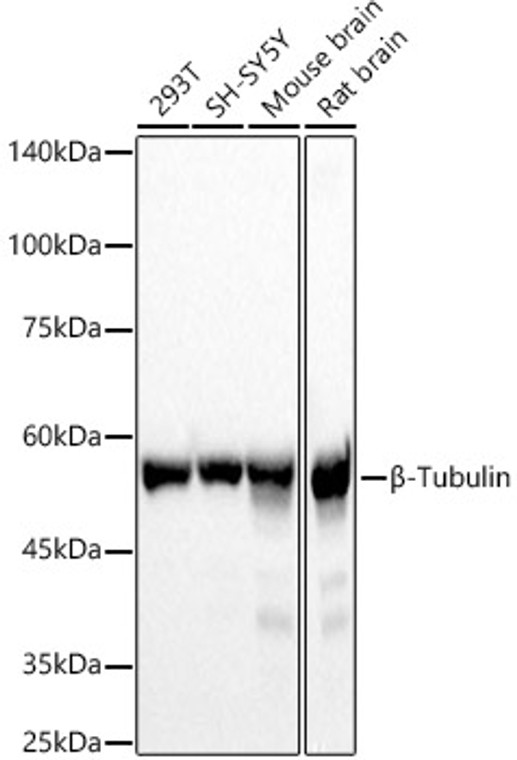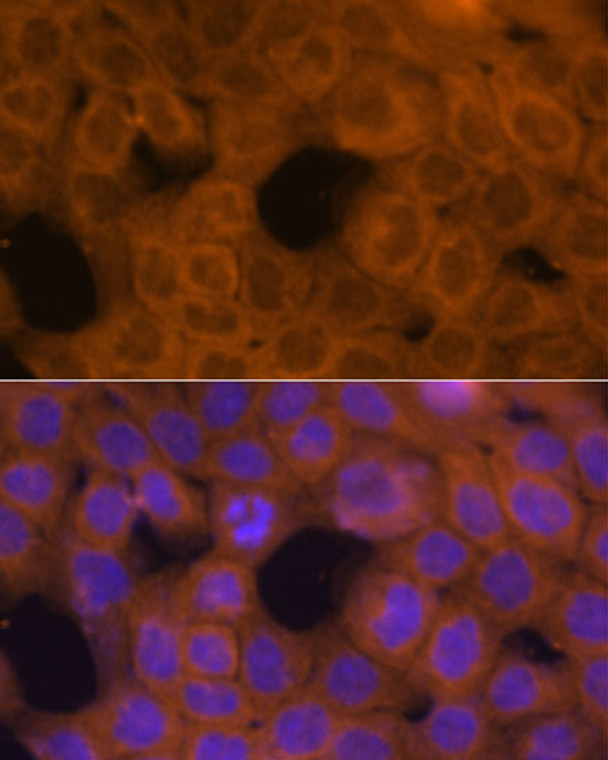| Host: |
Rabbit |
| Applications: |
WB/IHC/IF |
| Reactivity: |
Human/Mouse/Rat |
| Note: |
STRICTLY FOR FURTHER SCIENTIFIC RESEARCH USE ONLY (RUO). MUST NOT TO BE USED IN DIAGNOSTIC OR THERAPEUTIC APPLICATIONS. |
| Short Description: |
Rabbit polyclonal antibody anti-Beta-Tubulin (40-260) is suitable for use in Western Blot, Immunohistochemistry and Immunofluorescence research applications. |
| Clonality: |
Polyclonal |
| Conjugation: |
Unconjugated |
| Isotype: |
IgG |
| Formulation: |
PBS with 0.01% Thimerosal, 50% Glycerol, pH7.3. |
| Purification: |
Affinity purification |
| Dilution Range: |
WB 1:500-1:2000IHC-P 1:50-1:200IF/ICC 1:50-1:200 |
| Storage Instruction: |
Store at-20°C for up to 1 year from the date of receipt, and avoid repeat freeze-thaw cycles. |
| Gene Symbol: |
TUBB |
| Gene ID: |
203068 |
| Uniprot ID: |
TBB5_HUMAN |
| Immunogen Region: |
40-260 |
| Immunogen: |
Recombinant fusion protein containing a sequence corresponding to amino acids 40-260 of human Beta-Tubulin (NP_006077.2). |
| Immunogen Sequence: |
SDLQLERISVYYNEASSHKY VPRAILVDLEPGTMDSVRSG AFGHLFRPDNFIFGQSGAGN NWAKGHYTEGAELVDSVLDV VRKECENCDCLQGFQLTHSL GGGTGSGMGTLLISKVREEY PDRIMNTFSVVPSPKVSDTV VEPYNATLSIHQLVENTDET YCIDNEALYDICFRTLKLAT PTYGDLNHLVSATMSGVTTS LRFPGQLNADLRKLAVNMVP F |
| Tissue Specificity | Ubiquitously expressed with highest levels in spleen, thymus and immature brain. |
| Post Translational Modifications | Some glutamate residues at the C-terminus are polyglutamylated, resulting in polyglutamate chains on the gamma-carboxyl group. Polyglutamylation plays a key role in microtubule severing by spastin (SPAST). SPAST preferentially recognizes and acts on microtubules decorated with short polyglutamate tails: severing activity by SPAST increases as the number of glutamates per tubulin rises from one to eight, but decreases beyond this glutamylation threshold. Glutamylation is also involved in cilia motility. Some glutamate residues at the C-terminus are monoglycylated but not polyglycylated due to the absence of functional TTLL10 in human. Monoglycylation is mainly limited to tubulin incorporated into cilia and flagella axonemes, which is required for their stability and maintenance. Flagella glycylation controls sperm motility (Probable). Both polyglutamylation and monoglycylation can coexist on the same protein on adjacent residues, and lowering glycylation levels increases polyglutamylation, and reciprocally (Probable). Phosphorylated on Ser-172 by CDK1 during the cell cycle, from metaphase to telophase, but not in interphase. This phosphorylation inhibits tubulin incorporation into microtubules. |
| Function | Tubulin is the major constituent of microtubules, a cylinder consisting of laterally associated linear protofilaments composed of alpha- and beta-tubulin heterodimers. Microtubules grow by the addition of GTP-tubulin dimers to the microtubule end, where a stabilizing cap forms. Below the cap, tubulin dimers are in GDP-bound state, owing to GTPase activity of alpha-tubulin. |
| Protein Name | Tubulin Beta ChainTubulin Beta-5 Chain |
| Database Links | Reactome: R-HSA-2565942Reactome: R-HSA-380259Reactome: R-HSA-380270Reactome: R-HSA-380284Reactome: R-HSA-380320Reactome: R-HSA-5620912Reactome: R-HSA-6798695Reactome: R-HSA-8854518Reactome: R-HSA-9679191 |
| Cellular Localisation | CytoplasmCytoskeleton |
| Alternative Antibody Names | Anti-Tubulin Beta Chain antibodyAnti-Tubulin Beta-5 Chain antibodyAnti-TUBB antibodyAnti-TUBB5 antibodyAnti-OK antibodyAnti-SW-cl.56 antibody |
Information sourced from Uniprot.org
12 months for antibodies. 6 months for ELISA Kits. Please see website T&Cs for further guidance











![Anti-Beta-Tubulin antibody [TU-06] (STJ16100474) Anti-Beta-Tubulin antibody [TU-06] (STJ16100474)](https://cdn11.bigcommerce.com/s-zso2xnchw9/images/stencil/300x300/products/149191/346811/STJ16100474_1__95442.1681998917.jpg?c=1)

